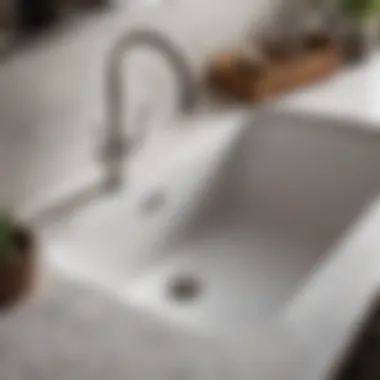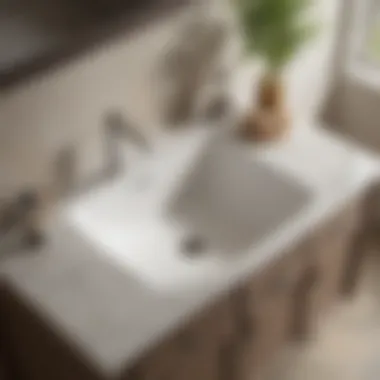Choosing the Perfect Undermount Sink for 24-Inch Cabinets


Intro
Installing an undermount bathroom sink in a 24-inch cabinet is both an aesthetic and practical improvement for your space. As compact bathrooms gain popularity, the choice of sinks and cabinets has evolved to fit these smaller dimensions while maintaining functionality. By opting for an undermount sink, you create a seamless look that elevates the overall design of your bathroom. This guide will provide a deep dive into the materials required, installation techniques, and the common challenges you may face, ensuring you are equipped with the information needed to tackle this DIY project successfully.
Materials:
When preparing for your installation, it’s vital you have all necessary materials on hand. Here is a list of items you'll need:
- Undermount sink (specific model depending on style preference): dimensions typically 18x13x7 inches.
- 24-inch bathroom cabinet: ensure it is well-constructed with no major defects.
- Silicone caulk: around 100% silicone formula for reliable adhesion.
- Plumber's putty: for sealing the drainage connection, about 1 small container.
- Plumbing supply kit: includes water supply lines and a trap, typically under 10 feet.
- Mounting clips: if not included with the sink, purchase sturdy 10-12 clips.
- Safety glasses: for personal protection.
- Cleaning agents: mild soap and water; ensure workspace is clean before starting.
Having these materials ready allows for a smoother installation process.
DIY Steps:
Detailed Instructions:
- Prepare your work area. Ensure the bathroom is clean, providing plenty of space to work comfortably.
- Measure your cabinet. Double-check the dimensions prior to purchasing a sink. An undermount sink should fit well within the cabinet without touching opposing walls.
- Remove existing sink and prep surface. If there's an old sink, carefully detach it, and reiterate that the counter is level and clean.
- Position the sink. Set the sink upside down onto the countertop to mark your cut with pencil. Maintain at least half an inch from the edges to avoid damaging the countertop.
- Cut the countertop opening. Using an appropriate saw, carefully make your cuts -- precision at this stage is vital.
- Apply adhesive and set sink. Generously apply silicone caulk underneath the rim of the sink and press it into place.
- Secure with mounting clips. Attach them according to the manufacturer's instructions to ensure stability.
- Connect plumbing. Install water supply lines and ensure a good seal using plumber’s putty at drain connection.
- Final installation verifies check. Before sealing the sink permanently, make necessary adjustments to position and test stability.
- Clean up any excess caulk. Let everything dry per your caulk’s manufacturer's instructions before using the sink.
Technical Aspects:
Tools Required:
- Drill and drill bits: for mounting clips and cutting surface.
- Jigsaw or oscillating tool: for cutting out the opening correctly.
- Tape measure: to verify precise measurements.
- Level: to ensure sink is sitting evenly.
Timing Specifcs:
- Preparation and material collection: approx 1-2 hours.
- Actual installation: depends on complexity, approx 2-4 hours.
Techniques for Quality:
- Use of silicone caulk ensures prevent leakage at the joints. Make sure to follow clean application techniques to ensure a pleasant finish.
DIY project Process:
Sequential Steps:
- Verify total fit of all items during the dry test prior to adhesive applications.
- When reaffirming sink fit, tackle any depth variations.
- Keep available shared time post-installation to resolve potential leak issues—allow standard curing time as described.
Troubleshooting Tips:
- If not adhesive, readagain application guides and retest clips. Ensure everything is(void). If there appears excess back up in drains, check for shared airflow adequately flushed. Adjust plumber’s system else adjust water spin position.
- In the event of sink misalignment, revisit initial position and snug fittings gently until optimization results.
"Careful planning is key to ensuring that installation of your undermount sink is successful. Address challenges timely to maintain efficiency."
Thus, prior preparation coupled with practical execution paves a successful DIY experience. Follow these guidelines and refined instruction bellows to properly integrate a modern undermount sink in a compact space.
Preamble to Undermount Bathroom Sinks
Undermount bathroom sinks have become a preferred choice for many homeowners, especially those working with 24-inch cabinets. This section is essential because it sets the stage for understanding what undermount sinks are and why they are a beneficial option for your bathroom. Choosing the right sink can deeply influence not only the function of your bathroom but also its overall aesthetics.
Definition and Characteristics of Undermount Sinks
An undermount sink is installed beneath the countertop and is supported from below. This unique design allows for a clean and streamlined look that can greatly enhance your bathroom’s overall feel. Undermount sinks are flush with the countertop surface, meaning there are no edges that protrude. This helps in an easier cleaning process as there are no grooves to trap debris.
There are various materials used for these sinks, each with their own characteristics. Common materials include
- Porcelain: A classic choice that is often used for its elegant appearance.
- Stainless Steel: Valued for its durability and resistance to stains and rust.
- Composite: Combining various materials for a tougher structure often available in several colors.
Utilizing quality materials helps ensure that when properly installed, undermount sinks withstand the wear and tear of daily use while maintaining a stylish appearance through the years.
Benefits of Choosing Undermount Sinks
When considering a sink for a 24-inch cabinet, you might ask yourself: why choose an undermount design? Several significant benefits stand out:
- Seamless Aesthetics: The hidden mounts create an uninterrupted countertop space, enhancing usability and elegance.
- Ease of Cleaning: The under-the-counter design prevents dust and grime buildup that typically occurs around lip areas down on top mount models.
- Countertop Choice Flexibility: Compatible with various countertop materials, undermount sinks can pair perfectly with granite, quartz, or marble.
Choosing an undermount sink is not only a matter of style but also practicality. It can strongly influence both efficiency in daily routines and the overall value of the bathroom renovation or design.
“The design of your bathroom is ultimately a reflection of your personal taste and functional needs.”
Understanding Inch Cabinet Specifications
The appropriate selection of an undermount bathroom sink is tightly bound to the specifications of a 24-inch cabinet. This section highlights the significance of understanding these specifications, as they dictate how well a sink integrates with the available space and functionality requirements of the overall bathroom design.
Standard Dimensions and Layout
When dealing with 24-inch cabinets, it is important to recognize the standard dimensions that most manufacturers follow. Typically, the width is 24 inches, but depth and height can vary considerably. Generally, a standard depth for bathroom vanities ranges from 18 to 22 inches. This amount of space influences how different sinks can be arranged. For instance, a rectangular undermount sink requires enough counter space to accommodate the greater width without compromising usability beyond the cabinet's edges.


Another vital aspect of layout concerns the distance from the wall. Leaving an adequate gap helps with water drainage and usage convenience. You’ll also want to think about the placement of the faucet to ensure easy access for everyday tasks like brushing teeth or washing hands. Placing a faucet too close or too far can ruin the intended usability.
Understanding the dimensions of your cabinet is crucial in optimizing both function and aesthetics. Selecting a sink that complements these dimensions fosters an organized and visually appealing bathroom space.
Considering Space Constraints
Space constraints play a crucial role in selecting the right undermount sink for a 24-inch cabinet. Often characterized by compact layouts, many bathrooms simply do not have the luxury of generous horizontal or vertical space. The conscious choice of sink will have a direct impact on how the overall design unfolds.
In order to effectively assess space limitations, a few standard considerations must be accounted for:
- Cabinet Height: Ensure that the sink does not occupy too much room above the countertop.
- Accessibility: A sink that juts out may create challenges for people using the space, especially children or the elderly.
- Storage Capacity: Sinks that are larger in size might consume the limited space available for other cabinate assets.
If you don't respect these constraints, you may find yourself in a predicament. For example, you might sacrifice drawer utility for a sink that looks attractive but is fundamentally impractical. Therefore, striking a balanced decision is paramount for a successful installation.
By analyzing both dimensions and space limitations, homeowners can positively uncertainly select the right undermount sink for their 24-inch cabinet.
Selecting the Right Undermount Sink
Choosing the right undermount sink is crucial for achieving both functionality and aesthetics in a 24-inch cabinet setting. It is essential to match the sink’s specifications to your intended use and available space. Different elements play significant roles in making the ideal selection, which includes material, shape, drain location, and size. Addressing these factors thoughtfully can ensure you enhance your bathroom’s style while maintaining practicality.
Material Options Available
Porcelain
Porcelain is quite popular in undermount bathroom sinks. Its smooth and glossy finish adds a classy feel to a bathroom. One key characteristic of porcelain is its resistance to stains that can arise from regular use. Its non-porous surface makes it easy to clean, which is beneficial for those wanting low maintenance.
However, porcelain can be prone to chipping if heavy objects are dropped on it, which is an aspect to consider for durability. Despite this, the timeless look it offers makes porcelain a preferred choice for many homeowners.
Stainless Steel
Stainless steel sinks are valued for their robustness. One significant aspect of this material is its resistance to rust and corrosion, which adds to its longevity. Stainless steel is durable and can handle heavy usage without issues, making it a common choice for busy bathrooms.
The unique feature of stainless steel is its ability to fit into modern bathroom designs effortlessly. Still, it can scratch, which may require more upkeep over time to maintain its brand-new appearance.
Composite
Composite sinks, made from resin and stone particles, provide an attractive blend of aesthetics and utility. They come in various colors and finishes, suitable for various design themes. One key benefit of composite sinks is their strength; they are reasonably resistant to scratches and chips.
Their unique feature lies in their versatility and the ability to mimic the looks of more expensive materials at a lower cost. The downside may be potential fading with sun exposure over time, which is worth considering when placing your sink.
Shape and Design Considerations
Rectangular
Rectangular sinks are highly efficient, maximizing the usage of space within the cabinet. Their design is a key aspect, especially when it comes to functionality, allowing more area for washing activities. Moreover, they can complement modern or contemporary designs very well.
One unique feature of rectangular sinks is their versatility to fit various countertop types ensuring age to jive with layout. Conversely, they may take up space if the countertop area isn't ample.
Round
Round sinks create a softer look, ideal for a style that is more traditional or rustic. The smooth edges provide safety, an essential quality for households with children. Their modest design is appealing for compact bathroom layouts, giving an airy feel.
A unique advantage of round sinks is the effective drainage they provide, reducing the risk of water pooling inside. However, they may not offer as much surface area for handwashing as rectangular ones do, which could be less practical.
Square
Square sinks represent modern artistry in design. Their sharp edges and bold look blend easily into an industrial style, making them quite attractive to a niche audience. Square designs are ideal for smaller spaces due to their alignment and require careful selection to ensure compatibility with cabinets.
While they promote a contemporary feel, their edges can create extra cleaning challenges making upkeep somewhat more demanding.
Drain Location and Size
Drain location is pivotal when selecting an undermount sink. Misalignment with pipes can lead to installation issues or unnecessary adjustments later. Additionally, the drain size determines how efficiently the water can exit the sink without causing overflow.
To select optimally, verifying the size of the existing plumbing before making choices is advised. Consult with installation experts or check specifications closely when choosing an undermount sink. Meeting with common dimensions would streamline the process for most cabinets.
When selecting the right undermount bathroom sink, consider both material and shape. Making an informed choice leads to better integration into your space.
Installation of Undermount Sinks
Installing undermount sinks is pivotal for enhancing both functionality and aesthetics in bathrooms, particularly for compact spaces with 24-inch cabinets. The importance of proper installation can impact not just the immediate use of the sink but also its long-term durability, ease of maintenance, and overall visual appeal. In these considerations, we will explore necessary preparations, tools, and a detailed installation process, giving readers clear guidance for a methodical approach.
Preparation and Tools Needed
Before beginning the installation process, gathering the right tools and preparing adequately is crucial. This will simplify the installation and mitigate potential issues. Key tools generally include:
- Drill and drill bits: Required for making holes for the faucet and other fixtures.
- Level: Ensures the sink sits evenly without tilting.
- Silicone sealant: Used to waterproof the edges to prevent water damage and mold growth.
- Pliers and wrenches: Essential for tightening connections and fittings securely.
- Putty knife: Helpful for removing any old materials from previous installations.


A well-organized space to work is also advisable. Gather all needed tools before starting, creating a smoother installation process.
Step-by-Step Installation Process
Removing the Old Sink
Removing the old sink allows for a fresh installation and is the first critical step in a proper undermount sink installation. The main aspect of this process involves detaching plumbing connections and unscrewing the current sink from the countertop. This removal reveals the workspace and highlights any existing damage to the area below.
The key characteristic of this step is thoroughness; ensuring that no previous materials impede the new installation is vital. Choosing to remove the old sink’s materials aids not only in workmanship but fosters a clear look at submerged cabinets and plumbing, which can reveal necessary corrections.
A notable advantage of this step includes discovering past leaks or damages that require immediate attention, thus preventing future complications. Take care to follow guidelines and have a supportive hand if needed.
Installing the Undermount Sink
Once the old sink is removed, the next task is installing the undermount sink itself. This step is about correctly positioning the sink under the countertop in perfect alignment with the cabinets. It is important to ensure adequate space and to measure before installation.
The key characteristic to focus on here is securing the sink to the countertop, which often involves applying adhesive and using clips to foster a firm bond. This method effectively addresses compatibility with various countertop materials, such as granite or quartz, enhancing its durability.
A unique feature of this process is ensuring the drop-in area of the installer lines up with the drains and plumbing lines, optimizing flow chances post-installation. While labor-intensive, a well-installed sink prevents not just water intrusion, but heightens the simplicity of cleaning provided by the eliminated lip.
Sealing and Finishing Touches
The final stage of sink installation emphasizes sealing and the finishing touches, which is equally critical in safeguarding against water exposure. Sealing is necessary for waterproofing the edges of the sink where it meets the countertop.
The characteristic that specifies this part of the installation is the use of high-quality silicone sealant. Properly applied sealant prevents moisture build-up and promotes the long-term viability of your installation. Quantum measure of care here protects the cabinet’s underside from rot.
One major advantage of this step is enhancing the overall look of the installation, providing a custom fit to the bathroom style. Remember to inspect for any gaps that might not have exited and dealing with them before finishing. It ensures resilience and function, echoing through future usage.
In summary, the meticulous steps of removing the old sink, installing the new undermount sink, and ensuring firm sealing create a seamless approach for structuring the bathroom with visual appeal and safety in mind. Each stage holds significant influence over the performance and aesthetics of your bathroom sink.
A well-installed undermount sink significantly improves the ease of cleaning and adds visual spaciousness to your bathroom.
For more tips and insights, Wikipedia and Britannica provide additional useful resources related to sink installation processes.
Aesthetic Impact of Undermount Sinks
The aesthetic impact of undermount sinks significantly influences the bathroom's mood and overall appearance. This section emphasizes how these sinks provide smooth transitions between countertop surfaces, thereby enhancing the visual complexity of your space. Notably, they provide an elegant look that can elevate the interior design of many bathrooms.
Enhancing Bathroom Design
Color Coordination
Color coordination is critical in achieving a harmonious look in your bathroom. Using the right colors can contribute to an inviting and restful environment. Choosing colors that complement your undermount sink, whether porcelain or stainless steel, ensures that the sink does not overpower the space but instead blends seamlessly with the chosen palette.
A key characteristic of effective color coordination is balance. Selecting hues that align harmoniously with your painted walls or tiled surfaces can create a coherent theme. Thus, opting for a white porcelain sink may work for a traditional clustered detail design, while a brushed nickel or dark stainless steel sink could appeal to modern sensibilities. A minor flaw, however, exists in striking this balance; too many competing colors can create a chaotic effect, detracting from the elegance intended.
Countertop Compatibility
Countertop compatibility connects you to choosing the right sink for the various surface materials utilized. Stone surfaces, quartz, and laminate are some compatible materials often seen in conjunction with undermount sinks. Addressing countertop materials is essential as not all surfaces suit undermount installations properly. For instance, a thick granite countertop may typically provide a sturdy base, while a thin laminate layer may not provide adequate support for mounting.
A vital feature of countertop compatibility lies in selecting a seamless fit rather than a contrasting appearance. An undermount sink can lend itself well to present countertops flush with no rises or dips, enhancing the aesthetic vibe of cleanliness in spaces, especially for those focused on elegant minimalism. However, this needs careful consideration; both sink and countertop selection should be of an appropriate thickness and material to ensure durability as well as enhanced looks.
Creating a Minimalist Look
Minimalist design often embraces simplicity, avoiding excessive decor and focusing on the functionality of each piece. Utilizing an undermount sink supports the concept of minimalism beautifully by decluttering countertop space. The unobtrusive mount offers a sleek profile, ensuring visual lines are clear and uninterrupted, which contributes to an open rather than closed-in feeling in particularly smaller bathrooms. The elegance of a minimalist setup can be further amplified through the careful selection of fixtures that match the sink’s style, creating an overall clean slate.
The right undermount sink combined with coordinated colors and compatible counters may just be the touch your bathrooms need to stand out.
In summary, the aesthetic contribution of undermount sinks cannot be overlooked. Understanding color coordination, counter compatibility, and minimalist principles can significantly enhance a small yet functional space's overall appeal.
Maintenance and Care
Maintenance and care of undermount bathroom sinks is vital to their longevity and continual appeal. An undermount sink seamlessly integrates into your countertop, giving a polished look. However, all types of sinks require some level of upkeep to ensure they function optimally over periods of use. A consistent maintenance regime provides not only aesthetics but also prolongs sink life and maintains hygiene.
Cleaning and Upkeep Tips
To maintain the shine and functionality of undermount sinks, consider the following tips:
- Regular Cleaning: Use a mild soap and water solution to avoid harmful chemicals that may degrade sink materials.
- Soft Cloths: Avoid abrasive materials that might scratch or dull the finish. Choose microfibre cloths to clean without causing damage.
- Routine Inspections: Regularly check for any mineral buildup or discoloration, taking action promptly.
- Avoid Harsh Chemicals: Cleaners like bleach or strong acids are often too aggressive, potentially harming your sink surface.
Addressing Common Issues
Dealing with maintenance issues become necessary over time. Understanding common problems, such as stains and cracks, will help you keep your sink in the best condition.
Dealing with Stains
Stains can be a nagging issue with any bathroom sink. The specific aspect of dealing with stains focuses on prevention and prompt action to treat them. The key characteristic of effective stain management is consistency. Utilizing gentle cleaning solutions as mentioned earlier supports fast action against the onset of staining. A beneficial choice for handling stains involves keen attention to immediate cleanup after spills. Food residue or cosmetic products can bond with sink surfaces if left untouched, leading to unsightly marks.


Special paste solutions specifically formulated for your sink material are ideal for tough stains. The unique feature of these applications is their targeted action: they lift stains without scratching the sink's finish. You may gain added longevity to your sink by adopting these practices—as stains linger and worsen without attention.
Handling Cracks
Cracks represent a significant maintenance challenge but can be effectively managed. When talking about handling cracks, quick response prevents water infiltration and more substantial damage downstream. Addressing crack issues promptly helps safeguard both sink aesthetics and functionality.
A popular approach for managing cracks utilizes epoxy or specific repair kits suited to your sink’s material. This characteristic approach allows for restoration rather than replacement, which can be a far more economical choice in maintaining your space. It's crucial to inspect repaired areas, ensuring adhesion and measurably assessing the repaired damage.
Understanding the importance of maintenance and care, alongside common issues, features support a well-constructed environment around your undermount bathroom sink. Committing to a powerful care strategy increases risks of prolongation and continued use.
Common Challenges with Undermount Sinks
Choosing an undermount sink for 24-inch cabinets presents unique challenges that many homeowners and housewives encounter. These challenges require careful consideration and understanding to ensure successful installation and effective use. Recognizing these issues help in making informed decisions, thereby enhancing both functionality and aesthetics of the bathroom.
Installation Difficulties
The installation of undermount sinks can pose various complications. One primary challenge is ensuring proper alignment and support. Unlike drop-in sinks, undermount sinks hang beneath the countertop. This design necessitates meticulous adjustments during the installation process. Without proper sealing, leaks may occur, creating subsequent issues such as water damage or mold growth.
When installing, it is essential to have the right tools. Common tools include:
- Drill: Needed for mounting brackets and securing the sink.
- Silicone caulk: Used to ensure a watertight seal around the edges.
- Level: To ensure the sink is perfectly horizontal.
Misalignments can lead to visible gaps that decrease visual appeal. Therefore, homeowners should consider whether they can competently execute these installations themselves or hire professionals. The costs associated with faulty installations can exceed those of hiring experienced installers initially.
Space Limitations
Space constraints in a bathroom also pose significant challenges. Although undermount sinks help save space, the dimensional properties of the cabinets and the plumbing systems installed may limit sink size and design choices. This limitation becomes evident particularly in smaller bathrooms, where every inch matters.
When considering the installation, it’s crucial to analyze:
- Countertop size: Undermount sinks require ample space around them for secure fitting.
- Cabinet depth: This influences the allowable sink designs.
Moreover, the plumbing system often encroaches into the cabinetry. Pipes may extend into areas that reduce the available space, thus restricting sink styles. Assessing your bathroom dimensions and seeking designs aligned with them becomes crucial for a fit.
Seeking solutions to these challenges often involves broad strokes of creative thinking and careful planning.
With careful planning, understanding, and perhaps professional advice, common challenges of undermount sinks can be navigated effectively, ensuring the enhancement of both usability and style in your small yet vital bathroom space.
Cost Considerations
When choosing an undermount bathroom sink, understanding the cost considerations is crucial. A careful approach to budgeting ensures that homeowners make informed choices, aligning their expectations aind resources. Not just the sink itself, but also installation costs and the running costs in the future need to be evaluated.
Budgeting for Undermount Sinks
Setting a budget serves as a foundation for any home improvement project. It helps guide not only the selection of the undermount sink but also dictates related expenses.
Factors to keep in mind include:
- Sink Price: Prices can vary greatly based on brand, material, and design choice. Standard sinks can cost anywhere from $100 to $500 or more.
- Installation Costs: Some homeowners prefer to do it themselves, but hiring a professional may add an additional $100 to $300. Complexity of installation sometimes can caus higher costs.
- Additional Fixtures: Keep in mind the associated expenses, like faucets, drains, and disposal costs, which could add to 20% of your udermount sink budget.
Establishing a thorough budget helps prevent overspending while still allowing for select quality options.
Comparative Pricing of Materials
Different materials lure different price tags. Recognizing the variations and assessing which material best fits your long-term needs and lower maintenance hassles is key.
Here are some common materials along with their price range:
- Porcelain: Affordable with prices often in the $150 to $300 range. However, porcelain can chip and scratch over time.
- Stainless Steel: Sturdy and durable, usual prices are $200 to $400. Finishes may affect overall cost, plus they are generally easy to keep clean.
- Composite: Typically mid-range, price range is about $150 to $400. They offer a balance between durability and aesthetic appeal, often mimicking natural stone.
These categories represent substantial variations in both upfront investment and longevity. Homeowners must prioritize both quality and price to maximize the advantage of their choice.
Always remember, the initial cost may reflect in the long-term satisfaction and benefit from your chosen product.
In essence, fully comprehending all dimensions of costs ensures that homeowners do not just choose a beautiful sink; they choose one that fits perfectly into their kitchen's design and lifestyle.
Finale
In finalizing this exploration, we recognize the critical role undermount bathroom sinks play in enhancing the functionality and aesthetics of 24-inch cabinets. The choice of sink must consider various elements such as material, design, and specific dimensions. Undermount sinks provide a seamless transition from sink to countertop, creating a sophisticated appearance.
This article has covered essential factors to help average house owners and housewives navigate the complexities of selecting and installing a sink. More importantly, the emphasis on maintenance ensures a lasting and visually appealing result.
Undermount sinks not only contribute to the looks of your bathroom but also ease daily tasks, making them a worthwhile investment.
Summary of Key Points
Undermount bathroom sinks suit compact 24-inch cabinets. Key points include:
- Material Considerations: Options such as porcelain, stainless steel, and composite each offer unique benefits and challenges.
- Design Features: Shapes like rectangular, round, and square must fit both style and a defined space.
- Installation Process: Careful planning and keen attention to steps help facilitate a smooth installation experience.
- Maintenance: Regular upkeep keeps the sink looking pristine over time and enhances its functional relevance.
- Cost Factors: Ultimately, understanding budget requirements and material costs is vital for the overall decision process.
Final Thoughts on Undermount Sinks for Inch Cabinets
When choosing an undermount sink for 24-inch cabinets, thoughtful consideration of design and utility is paramount. The insights shared in this article aim to shed light on crucial elements and practical advice, guiding readers toward making informed choices. This can elevate not just the style but also the usability of the bathroom space.
Investing in a durable sink delivers long-term satisfaction. A well-selected undermount sink complements other fixtures, effectively transforming compact spaces into welcoming areas. House points recognized in this guide inform decisions and lead to enhancing both value and overally satisfaction of the living environment.







